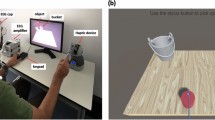Abstract
In this paper we introduce the combined use of Brain-Computer Interfaces (BCI) and Haptic interfaces. We propose to adapt haptic guides based on the mental activity measured by a BCI system. This novel approach is illustrated within a proof-of-concept system: haptic guides are toggled during a path-following task thanks to a mental workload index provided by a BCI. The aim of this system is to provide haptic assistance only when the user’s brain activity reflects a high mental workload. A user study conducted with 8 participants shows that our proof-of-concept is operational and exploitable. Results show that activation of haptic guides occurs in the most difficult part of the path-following task. Moreover it allows to increase task performance by 53% by activating assistance only 59% of the time. Taken together, these results suggest that BCI could be used to determine when the user needs assistance during haptic interaction and to enable haptic guides accordingly.
Access this chapter
Tax calculation will be finalised at checkout
Purchases are for personal use only
Preview
Unable to display preview. Download preview PDF.
Similar content being viewed by others
References
Wolpaw, J.R., Birbaumer, N., McFarland, D.J., Pfurtscheller, G., Vaughan, T.M.: Brain–computer interfaces for communication and control. Clinical Neurophysiology 113(6), 767–791 (2002)
Farwell, L.A., Donchin, E.: Talking off the top of your head: toward a mental prosthesis utilizing event-related brain potentials. Electroencephalography and Clinical Neurophysiology 70(6), 510–523 (1988)
Guger, C., Harkam, W., Hertnaes, C., Pfurtscheller, G.: Prosthetic control by an EEG-based brain-computer interface (BCI). In: Proc. European Conference for the Advancement of Assistive Technology (1999)
Allison, B., Graimann, B., Gräser, A.: Why use a BCI if you are healthy? In: ACE Workshop - Brain-Computer Interfaces and Games, pp. 7–11 (2007)
George, L., Lécuyer, A.: An overview of research on ”passive” brain-computer interfaces for implicit human-computer interaction. In: International Conference on Applied Bionics and Biomechanics, Venise, Italy (2010)
Zander, T.O., Kothe, C.: Towards passive brain–computer interfaces: applying brain–computer interface technology to human–machine systems in general. Journal of Neural Engineering 8(2) (2011)
Nijholt, A., Bos, D.P.O., Reuderink, B.: Turning shortcomings into challenges: Brain–computer interfaces for games. Entertainment Computing 1(2), 85–94 (2009)
Müller-Putz, G.R., Scherer, R., Neuper, C., Pfurtscheller, G.: Steady-state somatosensory evoked potentials: suitable brain signals for brain-computer interfaces? IEEE Transactions on Neural Systems and Rehabilitation Engineering 14(1), 30–37 (2006)
Cincotti, F., Kauhanen, L., Aloise, F., Palomäki, T., Caporusso, N., Jylänki, P., Mattia, D., Babiloni, F., Vanacker, G., Nuttin, M., Marciani, M.G., Millán, J.d.R.: Vibrotactile feedback for brain-computer interface operation. In: Computational Intelligence and Neuroscience (2007)
Chatterjee, A., Aggarwal, V., Ramos, A., Acharya, S., Thakor, N.: A brain-computer interface with vibrotactile biofeedback for haptic information. Journal of NeuroEngineering and Rehabilitation 4(1) (2007)
Feygin, D., Keehner, M., Tendick, R.: Haptic guidance: experimental evaluation of a haptic training method for a perceptual motor skill. In: Haptic Interfaces for Virtual Environment and Teleoperator Systems, pp. 40–47 (2002)
Bluteau, J., Sabine, C., Yohan, P., Edouard, G.: Haptic Guidance Improves the Visuo-Manual Tracking of Trajectories. PLoS ONE 3(3) (2008)
Asseldonk, E.H.F., Wessels, M., Stienen, A.H., van der Helm, F.C., van der Kooij, H.: Influence of haptic guidance in learning a novel visuomotor task. Journal of Physiology 103(3–5), 276–285 (2009)
Lécuyer, A., Lotte, F., Reilly, R., Leeb, R., Hirose, M., Slater, M.: Brain-computer interfaces, virtual reality, and videogames. Computer 41(10), 66–72 (2008)
Mühl, C., Gürkök, H., Plass-Oude Bos, D., Thurlings, M., Scherffig, L., Duvinage, M., Elbakyan, A., Kang, S., Poel, M., Heylen, D.: Bacteria Hunt: A multimodal, multiparadigm BCI game. In: International Summer Workshop on Multimodal Interfaces, University of Genua (2010)
Kohlmorgen, J., Dornhege, G., Braun, M., Blankertz, B., Müller, K.-R., Curio, G., Hagemann, K., Bruns, A., Schrauf, M., Kincses, W.: Improving human performance in a real operating environment through real-time mental workload detection. In: Dornhege, G., Millán, J.d.R., Hinterberger, T., McFarland, D., Müller, K.-R. (eds.) Toward Brain-Computer Interfacing, pp. 409–422. MIT press, Cambridge (2007)
Heger, D., Putze, F., Schultz, T.: Online workload recognition from EEG data during cognitive tests and human-machine interaction. In: Advances in Artificial Intelligence, pp. 410–417 (2010)
Pope, A.T., Bogart, E.H., Bartolome, D.S.: Biocybernetic system evaluates indices of operator engagement in automated task. Biological Psychology 40(1), 187–195 (1995)
Renard, Y., Lotte, F., Gibert, G., Congedo, M., Maby, E., Delannoy, V., Bertrand, O., Lécuyer, A.: OpenViBE: An Open-Source Software Platform to Design, Test and Use Brain-Computer Interfaces in Real and Virtual Environments. Presence 19, 35–53 (2010)
Hamadicharef, B., Zhang, H., Guan, C., Wang, C., Phua, K.S., Tee, K.P., Ang, K.K.: Learning EEG-based Spectral-Spatial Patterns for Attention Level Measurement. In: IEEE International Symposium on Circuits and Systems, Taipei, Taiwan, Province of China, pp. 1465–1468 (2009)
Blankertz, B., Tomioka, R., Lemm, S., Kawanabe, M., Müller, K.R.: Optimizing spatial filters for robust EEG single-trial analysis. IEEE Signal Processing Magazine 25(1), 41–56 (2008)
Peng, H., Long, F., Ding, C.: Feature selection based on mutual information criteria of max-dependency, max-relevance, and min-redundancy. IEEE Transactions on Pattern Analysis and Machine Intelligence 27(8), 1226–1238 (2005)
Williams, J., Michelitsch, G.: Designing effective haptic interaction: inverted damping. In: Extended Abstracts on Human Factors in Computing Systems, pp. 856–857. ACM (2003)
Author information
Authors and Affiliations
Editor information
Editors and Affiliations
Rights and permissions
Copyright information
© 2012 Springer-Verlag Berlin Heidelberg
About this paper
Cite this paper
George, L., Marchal, M., Glondu, L., Lécuyer, A. (2012). Combining Brain-Computer Interfaces and Haptics: Detecting Mental Workload to Adapt Haptic Assistance. In: Isokoski, P., Springare, J. (eds) Haptics: Perception, Devices, Mobility, and Communication. EuroHaptics 2012. Lecture Notes in Computer Science, vol 7282. Springer, Berlin, Heidelberg. https://doi.org/10.1007/978-3-642-31401-8_12
Download citation
DOI: https://doi.org/10.1007/978-3-642-31401-8_12
Publisher Name: Springer, Berlin, Heidelberg
Print ISBN: 978-3-642-31400-1
Online ISBN: 978-3-642-31401-8
eBook Packages: Computer ScienceComputer Science (R0)




